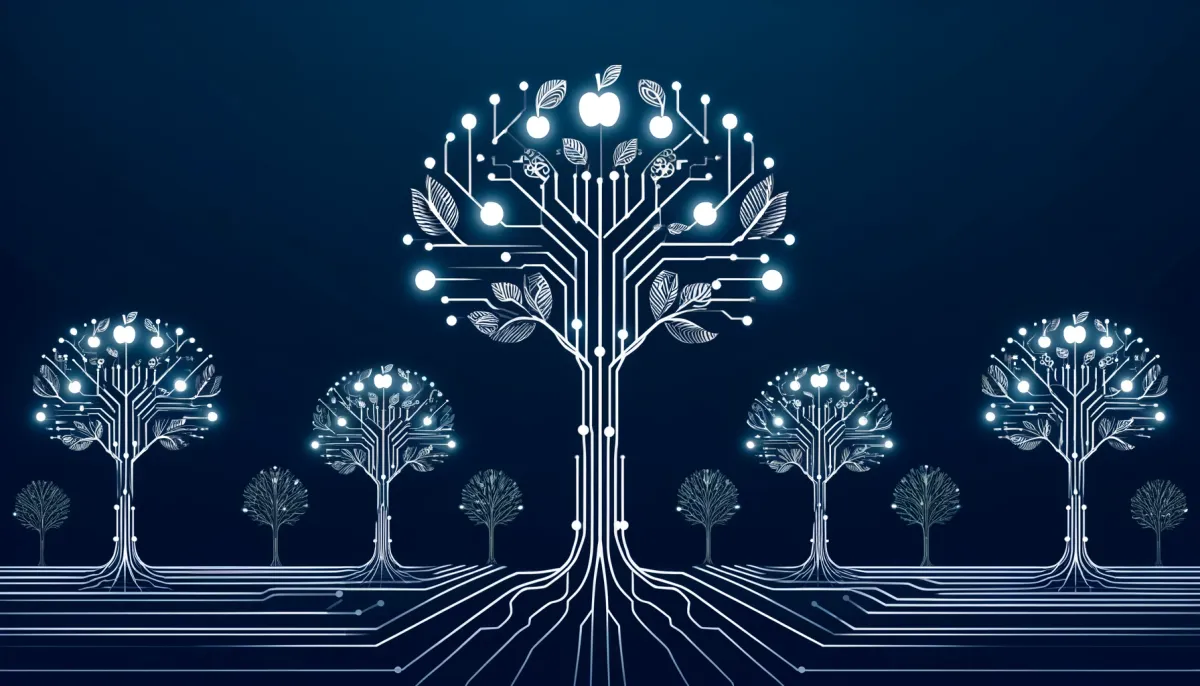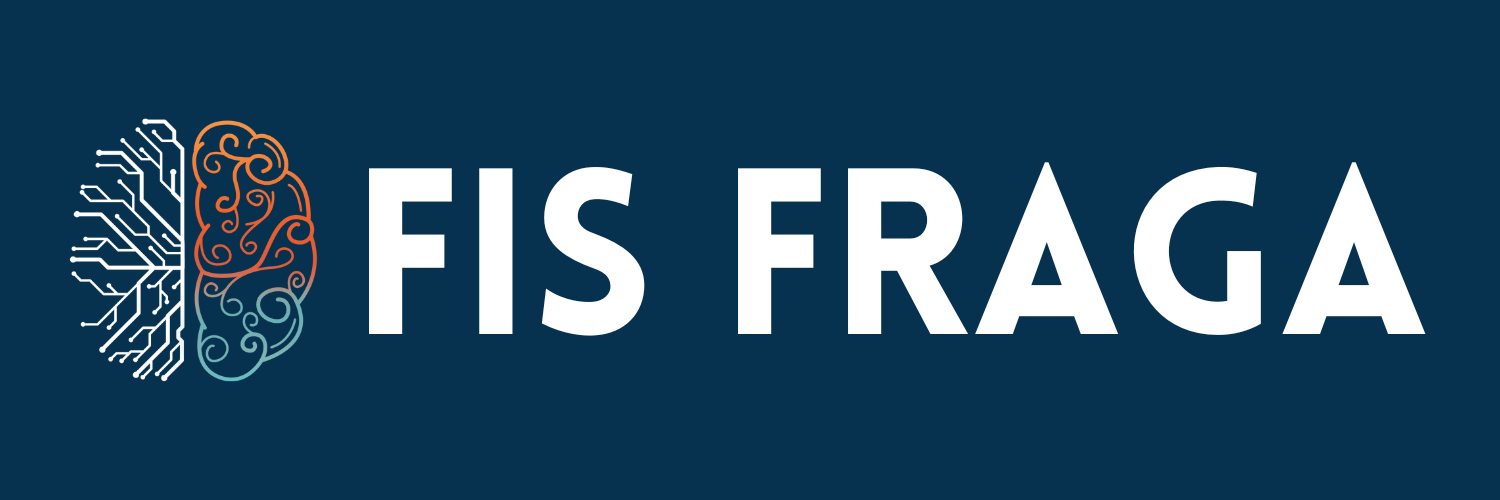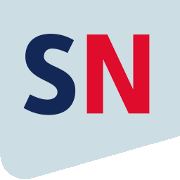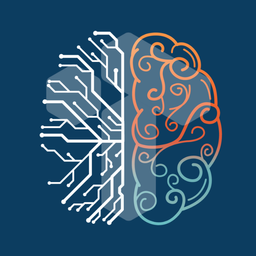no.25 - STOP Losing Notes. Always Find Notes with Super Folders.
Embrace the power of Retrieval Mechanisms and always find your notes in Tana.

“WHERE THE F*** IS THAT NOTE!?” 🤬
“I CAN'T BELIEVE THIS. I must have saved it somewhere…”
Have you ever felt like this (↑) before?
Well, this article is for you.
If you can't find your notes, you can't use your notes.
And this is a big problem, I understand.
But don't worry if you have a problem finding notes… Today we'll solve that problem.
I have a solution for you.
I literally wrote a Master's Thesis (and 2 scientific articles) about connecting notes with AI, and I decided to create an organization system for my notes designed specifically for Tana.
After profoundly studying the Building a Second Brain (BASB) methodology (and teaching it to hundreds of people), I decided to get what resonates and create my own organization system.
I consider it to be an evolved version of the PARA Method.
It presents a new paradigm to organize notes, based on networks instead of folders, where notes can belong to different places at the same time.
Just like the ideas in your mind.
Let me show you how it works…
💬 Quote: Retrieval
“In reality, information that cannot be reliably retrieved is not really being stored.”
– David Deutsch
This is the foundation of any organization system.
If you can't find information, it's not there.
Retrieval becomes a top priority in ANY information management system, otherwise you are just gambling.
IMPORTANT: Retrieval is important for humans AND for Artificial Intelligence.
As stated in a previous letter… Intelligence does not exist in a vacuum. (Artificial) Intelligence depends directly on the data you use.
Make AI's work easy.
Make your knowledge easy to retrieve.
“How?” – You ask.
Create a Network of Knowledge with Super Folders.
🖼️ Images: Super Folders
Super Folders are Retrieval Mechanisms used for you to retrieve notes exactly when you need them.
They are made of Fields, Supertags, and Searches.
Think of an important piece of information you want to retrieve.
Now, here's how Super Folders work:
There are two Supertags involved:
- Folder Category: The Place where you want to retrieve the information.
- Collected Information: The Information that you want to retrieve.
1. Folder Category Supertag
This supertag represents the Place where you want to retrieve the information.
The Folder Category Supertag will have Retrieval Searches that collect the Collected Information, and retrieves these objects for you.
This supertag works as a template. You will use this supertag to create the Folders themselves.
For example, you can create a tag for #project, and create as many projects as you wish with this tag, such as: Launch Voice Note AI Agent #project.
Each project created then becomes a Super Folder.
Each project is a unique Folder, and can be used to collect different pieces of information.
2. Collected Information Supertag
The Information that you want to retrieve.
This tag is added to the piece of information you want to retrieve later.
The Collected Information Supertag will have Retrieval Fields that send the information to the desired destinations (as many as you wish) where you want to retrieve this information.
For example, when you add the #voice note supertag to an information, you will be able to send this information into a Super Folder.
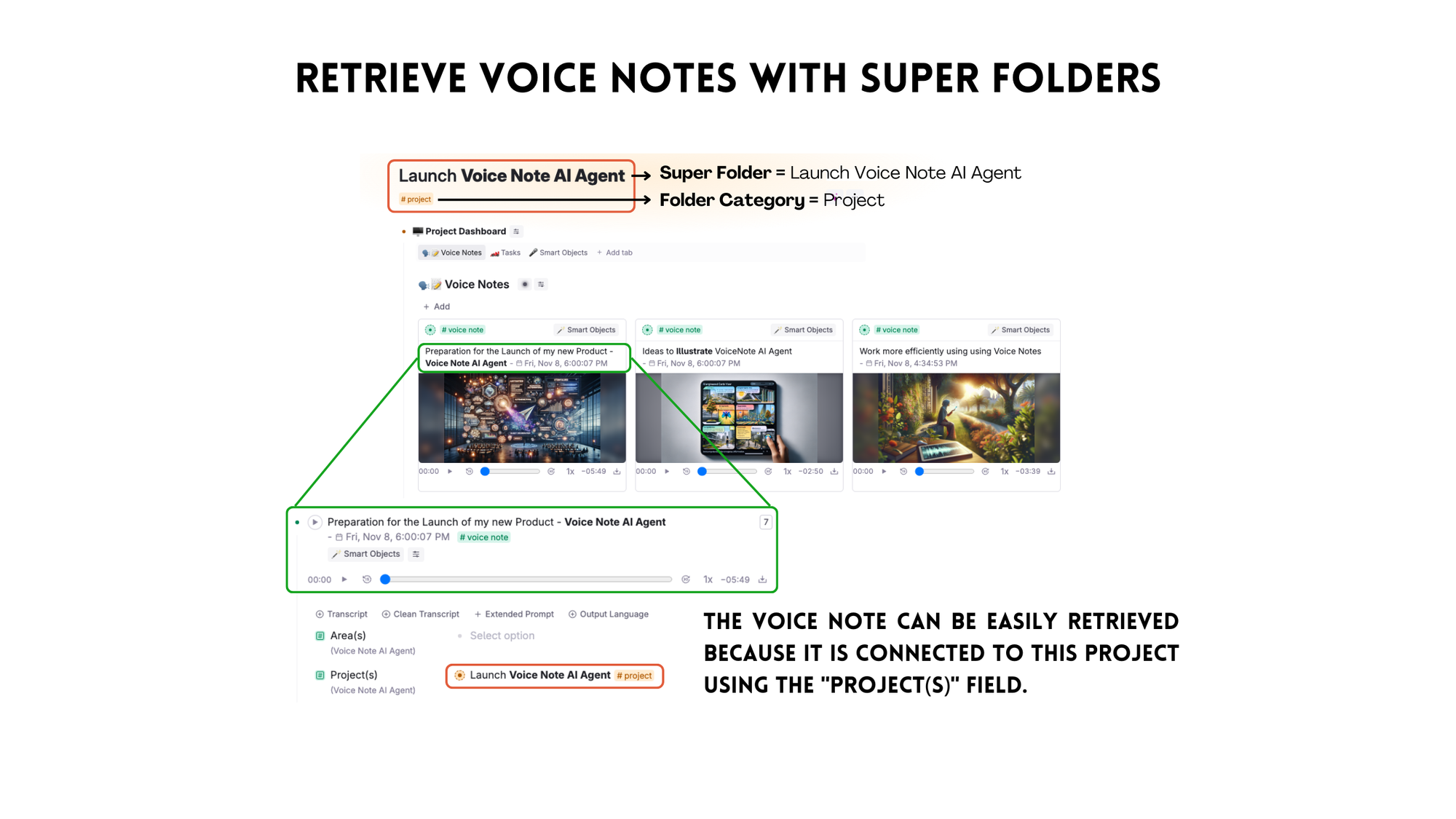
Let's take a deeper look at the components that make this possible, Retrieval Fields and Retrieval Searches.
IMPORTANT: For the rest of this example, let's use the #note supertag as the default Collected Information Supertag!
When we tag an information with the #note supertag, we can use the Retrieval Fields.
1. Retrieval Fields
For each Folder Category, there is a respective Retrieval Field that goes into the Collected Information supertag.
This field is used to send the piece of information to a Super Folder, as you will see below.
Super Folders work with 6 different Fields:
- Areas: Roles you play in life.
- Projects: Outcomes you're committed to.
- Action Zones: Places where you take action.
- Contemplations: Specific targets for reflection.
- Topics: General topics you're interested in.
- Sources: Books or courses the note came from.
These fields work to send the information into the respective Super Folders.
Let's look at an example using the #note supertag to bring up the Retrieval Fields.
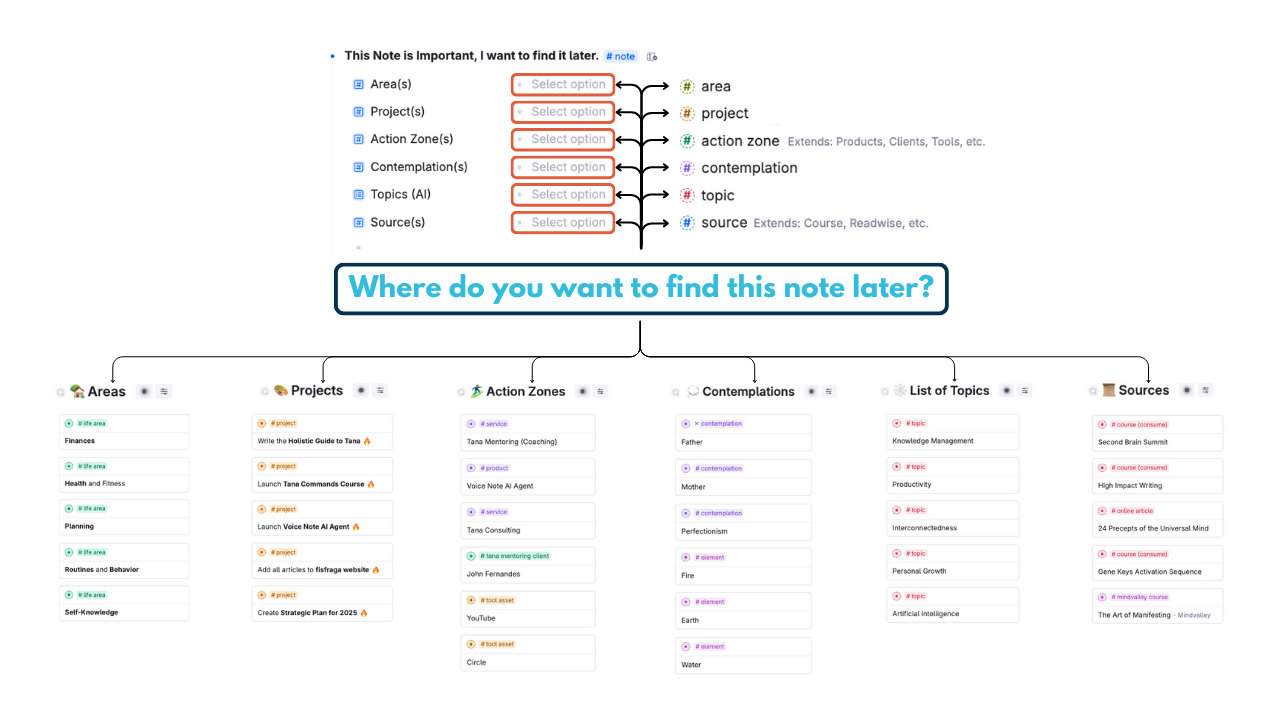
The main question you are asking yourself here is:
❓ Where do I want to find this note later?
The answer to this question will guide you to fill in the Retrieval Fields in the #note supertag.
Each of these fields sends the note to other places in Tana, represented by the respective supertags.
Fields are configured so that you can easily chose the appropriate destinations.
For example: start typing a project name, and project suggestions will appear.

Also keep in mind that you can assign the same #note to multiple places.
For example: a note may belong to a Book (Source) you're reading, while also belonging to a Content (Action Zone) you're writing, and an Area in your life, all at the same time.

By now, you're probably asking yourself…
How does this connect to the Searches?
2. Retrieval Searches
For each Folder Category, there is a Retrieval Search that is responsible for surfacing all the relevant information connected to the Super Folders.
Retrieval Searches collect all #notes at these 6 locations:
- Areas: Roles you play in life.
- Projects: Outcomes you're committed to.
- Action Zones: Places where you take action.
- Contemplations: Specific targets for reflection.
- Topics: General topics you're interested in.
- Sources: Books or courses the note came from.
Each Field is associated with a supertag.
In each of these supertags, a Retrieval Search is created to retrieve all the #notes that were assigned to this supertag (using the Field in the Search Expression).
These supertags represent the places where you actually retrieve your notes.
These are places where you will TAKE ACTION.
The Retrieval Mechanisms are oriented towards execution.
Find your notes → then → Execute on your notes.
For example: In this exact Tana Fis Letter which I'm writing (Always Find Notes with Retrieval Mechanisms was the original name), I can easily find all #notes assigned to this Action Zone, and execute on them.

📄 Note: Action Zones
Action Zones
Action Zones represent any digital container where action is taken.
An important part of Action Zones is that they collect your notes, and connect them directly to where action happens. The emphasis here being to bring knowledge to your action.
Action Zones are similar to what RJ Nestor refers to as 'bins', which are containers for tasks.
Let me give you an example.
Consider the PARA Method, by Tiago Forte, which is an organization system based on Actionability (Projects = most actionable, Archives = least actionable).
The first components are Projects and Areas, they are the most actionable ones, and are classic Action Zones.
Projects and Areas cover the biggest Action Zones.
But if you treat every digital container where action is taken as a Project or an Area, you will be prone to overfitting.
Overfitting is a concept from Machine Learning that is explained by the famous quote: "If the only tool you have is a hammer, it is tempting to treat everything as if it were a nail."
Yes, you can absolutely have 30 different Areas to keep track of. No one will stop you.
But you can also separate them into other Action Zones.
If you consider every single ‘ongoing responsibility’ at any given moment in time, that can easily become overwhelming.
Action Zones provide alternatives to categorize where Action happens. They are usually a sub-category of Projects or Areas, but with a different emphasis.
I consider the following to be Action Zones:
Sub-categories of Areas:
- Clients
- Products
- Tools / Software
- Etc.
Sub-categories of Projects:
- Contents
- Etc.
Each Client can be considered as an Area, same goes for each Product you sell, or every Tool (Software) you use.
All of those are ongoing responsibilities, and may demand action.
But we can all agree that email automations in ConvertKit (Tool), and landing page for Tana template (Product) belong to a different category than Financial Life (Area), or Health (Area).
With that in mind, I consider Areas to be the major Areas in life, while Action Zones are used to collect other types of responsibilities, such as clients, products, and tools.
As with contents, I believe content creation is much more dynamic than Project Management. Ideas don't have a clear target date, or a clear set of actions you need to take.
I avoid treating content pieces as projects, as I see them as two different categories.
"But Fis, why would you group different sub-categories into Action Zones?"
Instead of creating a new field for EACH of these categories (which would be overwhelming), I decided to group them all into Action Zones.
This way, one single field can handle several different categories.
Action Zones:
- Clients
- Products
- Tools / Software
- Contents
- Etc.
IMPORTANT: Action Zones are flexible.
You can easily expand this list by extending any other supertag with the #action zone supertag. This way, you can add other Action Zones that are unique to you.
I can't reveal much about this Tana System yet… 🤐
But I can tell you that this is a very powerful system in Tana that I've been building for over a year. It includes the Retrieval Mechanisms and several other PKM mindsets and concepts.
And of course, it integrates seamlessly with AI, following the research that I've been doing on AI and PKM since 2021 (more info below).
🔗 Further Reading
Creating Knowledge Connections for Personal Knowledge Management
Last week, my research on AI connections for PKM was published with Springer Nature Computer Science!
If you want to know more about the Field of 'Topics (AI)' that appears as one of the Retrieval Mechanisms, you can read the article to understand the methodology behind Topics.
Topics are equivalent to the Concepts in this article, they are automatically identified by AI and used to create a Network of Connection between your notes.
Here is the link for reading: https://rdcu.be/dHn5M

Hope you enjoy!
Thank you for reading!
Fis Fraga, M.Sc. is a Tana Ambassador and digital writer. He helps people develop a productive and fulfilling life using a mix of Knowledge Management and Artificial Intelligence.
You can read more at:
